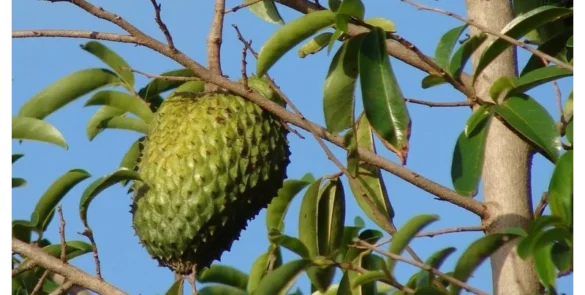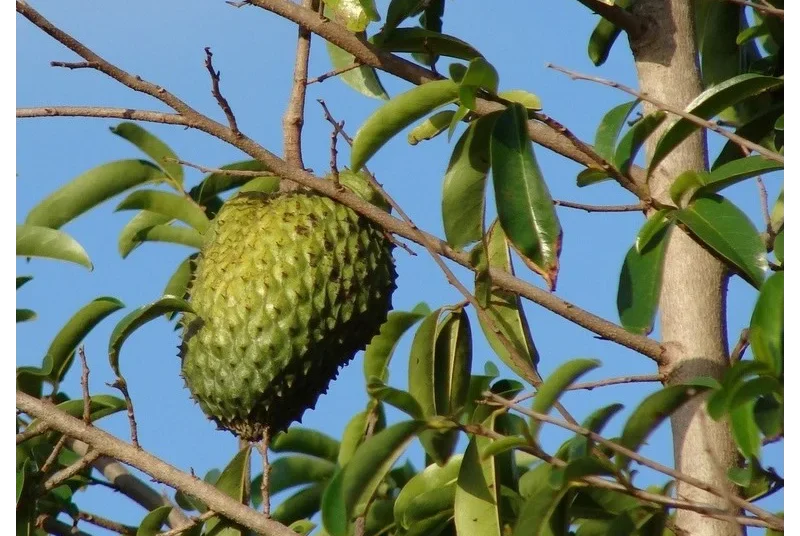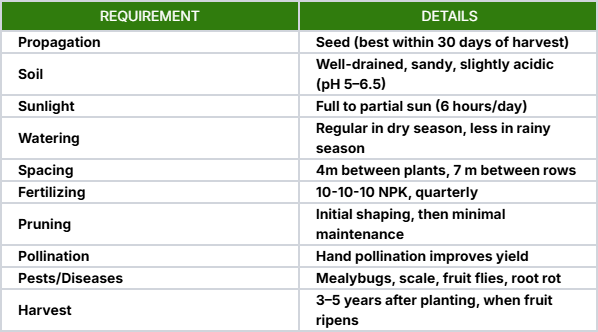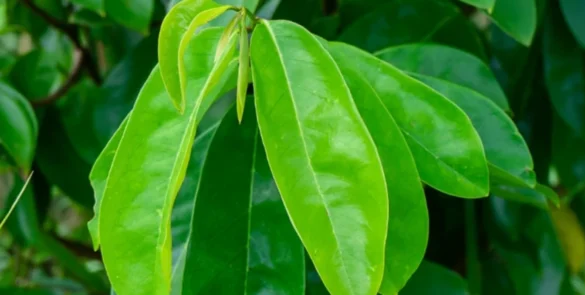soursop fruit tree

Soursop, also known as graviola, guyabano, or guanábana, is a tropical fruit tree native to the warm rainforests of Central and South America. While the fruit itself is prized for its unique flavor and creamy texture, the large, green leaves of the soursop tree have been used for centuries in traditional medicine practices.
Soursop Appearance and Characteristics
The soursop tree can grow up to 9 meters (30 feet) tall, with a dense canopy of glossy, oblong leaves that measure around 10-25 cm (4-10 inches) in length. The leaves have a distinct, slightly pungent aroma and are covered in a fine, velvety fuzz. When crushed or brewed, the leaves release a rich, earthy scent.
Key takeaways
- Climate: Sour sop trees thrive in warm, tropical/subtropical climates (USDA zones 10-11) with temperatures between 77-95°F (25-35°C). They cannot tolerate frost or freezing.
- Soil: Well-draining, fertile soil with a slightly acidic to neutral pH (6.0-7.5) is ideal. Provide regular deep watering, allowing soil to partially dry between waterings.
- Sunlight and Spacing: Full sun exposure is essential. Allow at least 25-30 feet (7.6-9.1 meters) between trees as they can grow quite large.
- Patience and Harvesting: Trees typically take 3-5 years to produce fruit, but leaves can be harvested sooner once established. Harvest leaves carefully to avoid excessive pruning.
Botanical Name and Family
The botanical name for sour sop is Annona muricata, and it belongs to the Annonaceae family, which includes other tropical fruit trees like cherimoya and custard apple.
Growing a Soursop Tree
If you live in a warm, tropical or subtropical climate, you may be able to grow your own soursop tree and harvest the leaves yourself. Here are some tips:
- Soursop trees thrive in USDA hardiness zones 10-11, with temperatures between 25-35°C (77-95°F).
- They require well-draining soil, full sun exposure, and consistent watering.
- Soursop trees thrive in USDA hardiness zones 10-11, with temperatures between 25-35°C (77-95°F).
- They require well-draining soil, full sun exposure, and consistent watering.
- Trees can take 3-5 years to produce fruit, but leaves can be harvested sooner.
- Harvest leaves carefully, avoiding damage to the tree.
Here are some tips for growing a soursop tree (Annona muricata) at home:

Climate and Growing Conditions: Soursop trees thrive in warm, tropical and subtropical climates. They grow best in USDA hardiness zones 10-11, with temperatures ranging from 25-35°C (77-95°F). They require full sun exposure and cannot tolerate frost or freezing temperatures.
Soil Requirements: Soursop trees prefer well-draining, fertile soil with a slightly acidic to neutral pH range of 6.0-7.5. They can tolerate sandy or clay loam soils but do not grow well in heavy, waterlogged conditions.
Planting and Spacing: Soursop trees can be grown from seeds or grafted saplings. When planting, choose a spot with full sun exposure and plenty of room for the tree to grow, as they can reach heights of 25-30 feet (7.6-9.1 meters) and a similar spread. Space trees at least 25-30 feet (7.6-9.1 meters) apart.
Water and Fertilizer Needs: Soursop trees require regular watering, especially when first establishing. Water deeply and allow the soil to partially dry out between waterings. Applying a balanced, slow-release fertilizer every 2-3 months during the growing season can help promote healthy growth.
Pruning and Maintenance: Prune soursop trees annually to remove dead, damaged, or overcrowded branches, and to shape the tree. Pruning should be done in late winter or early spring before new growth emerges.
Fruit and Leaf Production: Soursop trees typically take 3-5 years to begin producing fruit. However, leaves can be harvested sooner, once the tree is established. Harvest leaves carefully, avoiding excessive pruning or damage to the tree.
Pests and Diseases: Monitor for common pests like fruit flies, mealybugs, and scale insects. Diseases like anthracnose and root rot can also affect soursop trees. Proper cultural practices and organic pest management can help prevent and control issues.
Harvesting and Storage: Soursop fruit is typically harvested when it falls from the tree, indicating ripeness. Fresh leaves can be harvested as needed, but be sure to leave enough foliage for the tree’s health. Dried leaves can be stored in an airtight container for future use.
With the right climate, soil conditions, and care, growing a soursop tree at home can provide a source of fresh fruit and leaves for culinary or medicinal purposes. However, it’s essential to research and follow best practices for sustainable cultivation and responsible harvesting.
Summary Table: Key Soursop Growing Requirements

By following these guidelines, you can successfully grow and care for a soursop tree in suitable tropical or subtropical climates
Scientific Research on Soursop Leaves

In recent years, there has been growing scientific interest in studying the potential benefits and mechanisms of action of soursop leaves. Here’s a look at some of the key areas of research:
Anti-Cancer Potential: Several studies have investigated the anti-cancer properties of compounds found in soursop leaves, particularly acetogenins like annonacin, goniothalenin, and goniotalenin. These compounds have shown promising results in inhibiting the growth and proliferation of various cancer cell lines, including breast, lung, and colon cancer cells.
However, it’s important to note that most of these studies have been conducted in vitro (in test tubes or petri dishes) or on animal models. More clinical research is needed to determine the potential anti-cancer effects and safety of soursop leaf compounds in humans.
Anti-Inflammatory Mechanisms: Researchers have explored the anti-inflammatory potential of soursop leaves, with some studies suggesting that compounds like annonacin and annocatacin may help suppress inflammatory pathways and reduce the production of pro-inflammatory cytokines.
This anti-inflammatory activity could have implications for the treatment of various inflammatory conditions, such as arthritis, asthma, and autoimmune disorders. However, more research is needed to fully understand the mechanisms and potential therapeutic applications.
Antimicrobial and Antiviral Properties: Some studies have investigated the antimicrobial and antiviral properties of soursop leaf extracts. Preliminary research has suggested that these extracts may exhibit activity against certain bacteria, fungi, and viruses, potentially due to the presence of compounds like acetogenins and alkaloids.
While promising, more rigorous clinical studies are necessary to confirm the efficacy and safety of using soursop leaves as an antimicrobial or antiviral agent.
Proposed Mechanisms of Action: While the exact mechanisms of action are not fully understood, researchers have proposed several potential ways in which the compounds found in soursop leaves may exert their biological effects. These include:
- Inhibition of cellular enzymes and pathways involved in cancer cell growth and survival
- Induction of apoptosis (programmed cell death) in cancer cells
- Antioxidant and free radical scavenging activity
- Modulation of inflammatory pathways and cytokine production
- Antimicrobial and antiviral effects through disruption of microbial cell structures or inhibition of viral replication
It’s important to note that much of the research on sour sop leaves is still in the early stages, and more extensive studies are needed to fully understand their potential therapeutic applications and ensure their safety and efficacy.
Benefits of Soursop Leaves
While more research is still needed, preliminary studies and traditional use suggest that soursop leaves may offer a range of potential health benefits due to their unique phytochemical composition.
Rich in Antioxidants: Soursop leaves are packed with potent antioxidants, including flavonoids, alkaloids, and phenolic compounds. These antioxidants help neutralize free radicals and combat oxidative stress, which is linked to various chronic linked to various chronic diseases and aging.
“Graviola leaf extracts showed significant antioxidant activity, indicating their potential use as a natural source of antioxidants.”
Anti-Inflammatory Properties: Compounds found in soursop leaves, such as annonacin and annocatacin, have been studied for their potential anti-inflammatory effects. Chronic inflammation is a contributing factor to many health issues, including arthritis, heart disease, and certain cancers.
Potential Anti-Cancer Effects: Preliminary research has suggested that soursop leaves may exhibit anti-cancer properties. Some studies have indicated that compounds in the leaves, like acetogenins, could potentially inhibit the growth and spread of certain cancer cells. However, more research is needed to fully understand these effects and mechanisms.
Traditional Uses: In many traditional medicine systems, soursop leaves have been used for centuries to treat a variety of conditions, including:
- Infections (bacterial, viral, and fungal)
- Insomnia and anxiety
- Hypertension and heart conditions
- Diabetes and blood sugar regulation
- Pain and inflammation
While these traditional uses are anecdotal, they suggest that soursop leaves may offer a range of potential benefits that are worth further scientific investigation.
How to Use Soursop Leaves
There are several ways to incorporate sour sop leaves into your routine and potentially benefit from their unique properties:
- Herbal Tea Infusion: One of the most common ways to consume soursop leaves is by brewing them into a herbal tea. To prepare, simply steep a few fresh or dried leaves in hot water for 5-10 minutes. You can add honey, lemon, or other natural flavors if desired.
- Extract or Supplement Form: Soursop leaf extracts and supplements are available in capsule, tablet, or liquid form. These concentrated preparations can provide a more potent dose of the active compounds found in the leaves.
- Topical Application: Traditionally, soursop leaf poultices or infusions have been applied topically to the skin to treat various skin conditions, such as eczema, psoriasis, and fungal infections.
- Culinary Use: Fresh or dried soursop leaves can be used to add flavor and potential health benefits to soups, stews, or other savory dishes. However, it’s important to note that the leaves should not be consumed in large quantities due to potential toxicity concerns (more on this later).
Typical Dosages and Preparation Methods:
- For tea, use 1-2 teaspoons of dried leaves or 2-3 fresh leaves per cup of hot water.
- Supplement dosages may vary, but typically range from 300-1000mg per day of standardized extract.
- Always follow the instructions on the product label and consult with a healthcare professional before taking any new supplement.
Traditional Uses of Soursop Leaves
While modern scientific research is still exploring the potential benefits of soursop leaves, these leaves have been used for centuries in traditional medicine practices throughout the Americas and the Caribbean. Here are some of the historical uses:
Treating Infections: Soursop leaf infusions and extracts were commonly used to combat various types of infections, including bacterial, viral, and fungal infections. The leaves were believed to have antimicrobial properties that could help fight off pathogens.
Insomnia and Anxiety Relief: In many traditional medicine systems, soursop leaves were used as a natural sedative and nerve tonic. They were consumed as a tea or tincture to promote relaxation, improve sleep quality, and reduce anxiety.
Hypertension and Heart Health: Graviola leaves were traditionally employed to help lower blood pressure and support cardiovascular health. The leaves were believed to have vasodilatory effects, helping to improve blood flow and reduce the strain on the heart.
Diabetes and Blood Sugar Regulation: Some traditional practices involved using soursop leaf preparations to help regulate blood sugar levels and potentially manage symptoms of diabetes. The leaves were thought to have hypoglycemic effects.
Pain and Inflammation Relief: Due to their potential anti-inflammatory properties, soursop leaves were often used topically or consumed as a tea to help alleviate pain, swelling, and inflammation associated with various conditions, such as arthritis and injuries.
While these traditional uses are based on anecdotal evidence and cultural practices, they highlight the long-standing belief in the therapeutic potential of sour sop leaves across many regions and indigenous cultures.
Where to buy soursop leaves
Buying Soursop Leaves:
- Look for fresh or dried soursop leaves at local health food stores, ethnic markets, or online retailers specializing in herbal products.
- Soursop leaf extracts, tinctures, and supplements may also be available at some stores or online.
If you’re interested in incorporating soursop leaves into your routine, it’s important to be an informed consumer and choose high-quality products. Here are some tips for buying soursop leaf products:
Forms Available:
- Dried Leaves: These can be used to make teas or added to various recipes.
- Leaf Extracts: Available in liquid or powdered form, extracts are concentrated preparations that may contain higher levels of active compounds.
- Capsules or Tablets: Encapsulated soursop leaf powder or extracts can provide a convenient and pre-measured dosage.
What to Look for in Quality Products:
- Look for products that clearly list the botanical name “Annona muricata” and specify that they contain sour sop leaves (not other plant parts).
- Check for third-party testing and certifications, such as organic, non-GMO, or GMP (Good Manufacturing Practices) certifications.
- Opt for reputable brands with transparent sourcing and manufacturing processes.
- Avoid products with excessive fillers, additives, or preservatives.
Trusted Brands and Suppliers: While recommendations may vary by location, some trusted brands and suppliers of soursop leaf products include:
- Starwest Botanicals
- Mountain Rose Herbs
- Organic India
- Gaia Herbs
- Nutra Supplements
It’s always a good idea to do your research, read reviews, and consult with a healthcare professional before trying any new supplement or herbal product, including those derived from sour sop leaves.
Potential Side Effects and Interactions

While soursop leaves have been used traditionally for centuries, it’s important to be aware of potential precautions and side effects:
Toxicity Concerns: Some studies have suggested that soursop leaves, and particularly the compound annonacin, may be neurotoxic and potentially contribute to conditions like Parkinson’s disease when consumed in large amounts over an extended period. However, more research is needed to confirm these findings.
Medication Interactions: Soursop leaves may interact with certain medications, such as chemotherapy drugs, anticoagulants, and others. It’s essential to consult with a healthcare professional before consuming sour sop leaf products, especially if you are taking any prescription medications.
Who Should Avoid Soursop Leaves:
- Pregnant or breastfeeding women should avoid consuming soursop leaves due to a lack of safety research.
- Children and infants should also avoid soursop leaf products, as their effects in these populations are unknown.
- Individuals with certain medical conditions, such as Parkinson’s disease or neurological disorders, should exercise caution and consult with a healthcare professional before using sour sop leaf products.
As with any supplement or herbal remedy, it’s crucial to consult with a qualified healthcare professional before incorporating sour sop leaves into your routine, especially if you have any existing medical conditions or are taking medications.
More Potential Side Effects and Interactions
While soursop leaves have been used traditionally for centuries and show promising potential benefits, it’s essential to be aware of potential side effects and interactions with medications or other supplements. Here are some important considerations:
Neurotoxicity Concerns: One of the primary concerns surrounding the consumption of soursop leaves is the potential for neurotoxicity. The leaves contain compounds called acetogenins, particularly annonacin, which have been linked to neurodegenerative diseases like Parkinson’s disease in some studies.
However, it’s important to note that these studies were conducted on animals and involved administering highly concentrated doses of annonacin over an extended period. The risk from consuming moderate amounts of sour sop leaves is still unclear and requires further research.
Despite this uncertainty, it’s generally recommended that individuals with existing neurological conditions or those at risk for such conditions exercise caution and consult with a healthcare professional before consuming sour sop leaf products.
Interactions with Medications: Sour sop leaves may interact with certain medications, potentially altering their effectiveness or increasing the risk of adverse effects. Some potential interactions include:
- Blood thinners (anticoagulants): Soursop leaves may enhance the effects of blood thinners like warfarin, increasing the risk of bleeding.
- Chemotherapy drugs: Compounds in soursop leaves, such as acetogenins, may interfere with the effectiveness of chemotherapy drugs used to treat cancer.
- Diabetes medications: Soursop leaves may have hypoglycemic effects, potentially increasing the risk of low blood sugar when combined with diabetes medications.
- Immunosuppressants: The leaves may impact the effectiveness of drugs that suppress the immune system, such as those used in organ transplant recipients.
Pregnancy and Breastfeeding: Due to a lack of safety data, it’s generally recommended that pregnant and breastfeeding women avoid consuming sour sop leaves or other products derived from the plant. The potential risks to the developing fetus or nursing infant are not well understood, and it’s best to err on the side of caution.
Allergic Reactions: As with any botanical or herbal product, there is a risk of allergic reactions in some individuals. Those with known allergies to plants in the Annonaceae family or a history of sensitivity to sour sop should exercise caution and consult with a healthcare professional before using sour sop leaf products.
It’s important to note that while these potential side effects and interactions are concerning, they do not necessarily negate the potential benefits of sour sop leaves. However, they do highlight the need for caution and proper guidance from healthcare professionals, especially for individuals with pre-existing medical conditions or those taking medications.
By being aware of these potential risks and consulting with qualified professionals, individuals can make informed decisions about whether incorporating sour sop leaves into their routines is appropriate and safe for their specific circumstances.
Environmental Impact and Sustainability Considerations

As the demand for soursop leaves and their potential therapeutic applications continues to grow, it’s crucial to consider the environmental impact and sustainability aspects of their cultivation and harvesting. Here are some key factors to consider:
- Deforestation and Habitat Loss: The soursop tree (Annona muricata) is native to the tropical regions of Central and South America, as well as parts of the Caribbean. Unsustainable or illegal cultivation practices, especially in these regions, can contribute to deforestation and habitat loss for various plant and animal species.
It’s essential to promote sustainable agroforestry practices, such as intercropping soursop trees with other crops, to minimize the environmental impact and preserve biodiversity in these regions.
- Water and Soil Conservation: Soursop trees are known to be relatively drought-tolerant and can thrive in various soil types. However, excessive or inefficient irrigation practices, as well as the overuse of chemical fertilizers and pesticides, can lead to water pollution, soil degradation, and negative impacts on local ecosystems.
Encouraging the adoption of sustainable farming techniques, such as water-efficient irrigation systems, organic fertilizers, and integrated pest management strategies, can help mitigate these environmental concerns.
- Carbon Footprint and Climate Change: Like any agricultural product, the cultivation, processing, and transportation of soursop leaves and related products contribute to greenhouse gas emissions and the overall carbon footprint of the industry.
Implementing strategies to reduce energy consumption, promote renewable energy sources, and optimize transportation logistics can help minimize the carbon footprint associated with the sour sop leaf supply chain.
- Sustainable Harvesting Practices: The harvesting of soursop leaves can also have an impact on the overall health and productivity of the trees if not done properly. Overharvesting or improper pruning techniques can stress the trees and reduce their long-term viability.
Promoting sustainable harvesting practices, such as selective pruning and allowing for adequate regrowth periods, is crucial to ensuring a consistent and long-term supply of soursop leaves without compromising the health of the trees.
- Waste Management and Recycling: Like any agricultural or industrial process, the production and processing of soursop leaf products can generate waste materials, such as plant trimmings, packaging materials, and processing byproducts.
Implementing effective waste management strategies, including composting, recycling, and responsible disposal of any potentially hazardous materials, can help minimize the environmental impact and promote a more circular economy within the sour sop leaf industry.
By addressing these environmental and sustainability considerations, we can ensure that the growing demand for sour sop leaves does not come at the expense of degrading our natural resources or contributing to further environmental challenges.
Collaboration between researchers, growers, manufacturers, regulatory bodies, and consumers is essential to promote sustainable and environmentally responsible practices throughout the entire supply chain of sour sop leaf products.
Embracing a holistic approach that balances economic, social, and environmental factors can help us harness the potential benefits of sour sop leaves while preserving the delicate ecosystems and natural habitats from which these remarkable plants originate.
My Conclusion
Sour sop leaves hold immense potential as a natural therapeutic resource, thanks to their unique phytochemical composition and traditional use across various cultures.
While promising research highlights possible antioxidant, anti-inflammatory, and even anti-cancer properties, more rigorous clinical studies are needed to fully understand their efficacy and safety profiles.
As interest in sour sop leaves continues to grow, it’s crucial to prioritize sustainable cultivation practices, ethical sourcing, and robust quality control measures.
Fostering interdisciplinary collaboration between researchers, healthcare professionals, and indigenous communities can help unlock the true potential of these remarkable leaves while preserving cultural heritage and biodiversity.
Frequently Asked Questions
What is a soursop tree?
The soursop tree (Annona muricata), also known as graviola or guyabano, is a tropical fruit tree native to Central and South America. These evergreen trees grow up to 30 feet tall with glossy leaves and produce large, spiky green fruits with sweet, creamy white flesh.
What climate do soursop trees need?
Soursop trees require:
- Temperature: 77-95°F (25-35°C) year-round
- USDA zones: 10-11 only
- Frost tolerance: None – will die in freezing temperatures
- Conditions: High humidity and consistent moisture
How do you plant and care for a soursop tree?
Planting: Use well-draining, fertile soil (pH 6.0-7.5) in full sun with 25-30 feet spacing between trees.
Care: Water deeply but allow soil to partially dry between waterings. Apply balanced fertilizer every 2-3 months during growing season. Prune annually in late winter and monitor for pests like fruit flies and scale insects.
How long until soursop trees produce fruit?
Trees typically take 3-5 years to begin producing fruit when grown from seed. Grafted trees may fruit slightly sooner. They produce fruit year-round in ideal tropical conditions.
Can you grow soursop trees indoors?
While possible in large containers when young, soursop trees are challenging indoors long-term due to their size (25-30 feet), intense light requirements, and need for high tropical humidity. Indoor trees rarely produce fruit.
What pests and diseases affect soursop trees?
Common issues:
- Fruit flies, mealybugs, and scale insects
- Anthracnose fungal infections and root rot
- Leaf spot diseases in humid conditions
Prevention: Ensure proper spacing, avoid overwatering, and use organic pest management practices.
When do you harvest soursop fruit and leaves?
Fruit: Harvest when it falls naturally from the tree (indicates ripeness). Ripe fruit yields slightly to pressure and should be consumed within 2-3 days.
Leaves: Harvest mature, healthy leaves once the tree is established, avoiding excessive pruning that damages tree health.
Disclaimer: This information is for educational purposes only and doesn’t replace professional medical advice. Consult healthcare providers before using soursop leaves for medicinal purposes, especially if you have medical conditions or take medications.
Contents
- 1 soursop fruit tree
- 2 Soursop Appearance and Characteristics
- 3 Key takeaways
- 4 Botanical Name and Family
- 5 Growing a Soursop Tree
- 6 Summary Table: Key Soursop Growing Requirements
- 7 Scientific Research on Soursop Leaves
- 8 Benefits of Soursop Leaves
- 9 How to Use Soursop Leaves
- 10 Potential Side Effects and Interactions
- 11 More Potential Side Effects and Interactions
- 12 Environmental Impact and Sustainability Considerations
- 13 My Conclusion
- 14 Frequently Asked Questions
- 15 What is a soursop tree?
- 16 What climate do soursop trees need?
- 17 How do you plant and care for a soursop tree?
- 18 How long until soursop trees produce fruit?
- 19 Can you grow soursop trees indoors?
- 20 What pests and diseases affect soursop trees?
- 21 When do you harvest soursop fruit and leaves?
